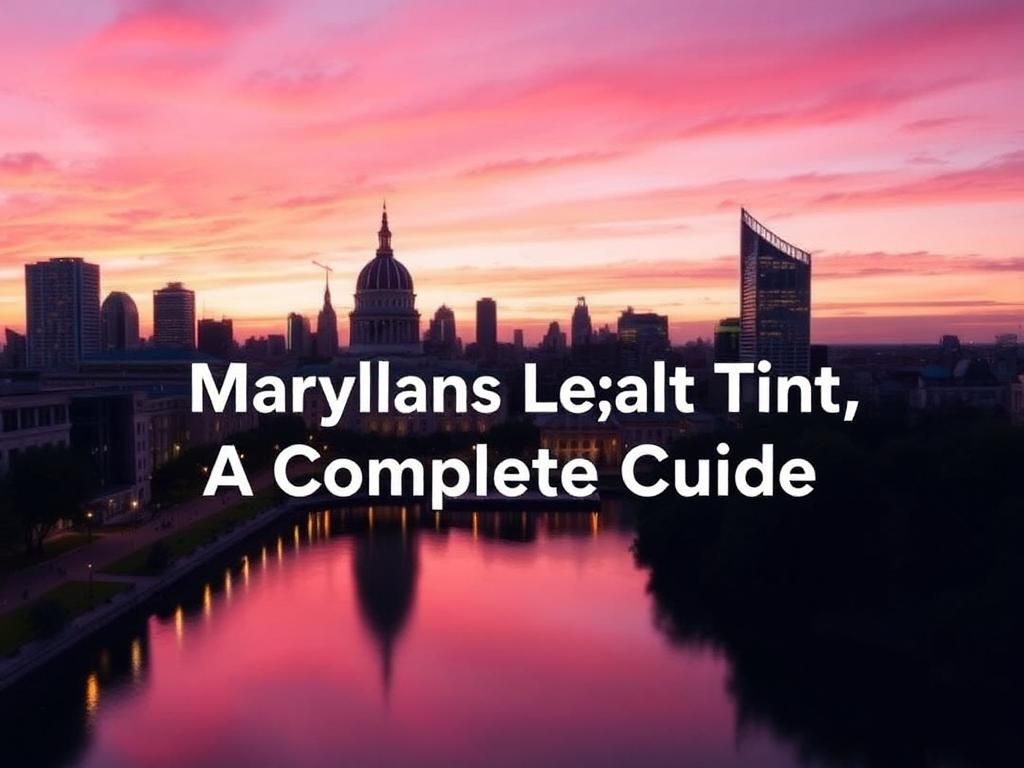Window tinting has evolved from a trend to a necessity for many vehicle owners, enhancing privacy, increasing comfort, and protecting interiors from the sun’s harmful rays. However, understanding the nuances of Maryland legal tint is crucial for compliance with state regulations. This article serves as a comprehensive guide for Maryland residents, detailing everything from the definition of window tinting to specific state laws, acceptable tint types, consequences of non-compliance, and tips for staying within legal boundaries.
Introduction to Maryland Legal Tint
Definition of Window Tinting
Window tinting involves applying a thin film to the windows of vehicles, which serves several purposes. Primarily, it reduces glare and limits the amount of ultraviolet (UV) light entering the vehicle, thus enhancing comfort for passengers. The practice dates back decades, originally intended to offer aesthetic appeal and heat protection. Today, technological advancements have led to a variety of options tailored to both functionality and legal requirements.
Importance of Understanding Legal Tint Restrictions
The importance of understanding legal tint restrictions cannot be overstated. Compliance with state laws not only protects drivers from potential fines but also plays a crucial role in safety considerations. Tints that are too dark or reflective can hinder visibility, leading to hazardous driving conditions. Additionally, many insurance companies require compliance with local regulations; failing to adhere could impact coverage and claims processing.
Maryland Tint Laws Overview
Maryland Statutes Regarding Window Tinting
Maryland’s tint laws are explicitly governed by regulations outlined in the Maryland Transportation Article. These laws specify the allowable limits for different windows in a vehicle to ensure safety and compliance. The regulations are designed to maintain visibility for drivers while providing the benefits associated with window tinting.
Legal Limits for Window Tinting
| Window Type | VLT (Visible Light Transmission) | Notes |
|---|---|---|
| Front Windshield | Must allow 70% of light in | Non-reflective tint allowed above the manufacturer’s AS-1 line |
| Front Side Windows | Must allow 38% of light in | No reflectivity limit |
| Back Side Windows | No restrictions | Any tint darkness is permitted |
| Rear Windows | No restrictions | Any tint darkness is permitted |
Understanding these limits is essential for Maryland drivers looking to customize their vehicles. Maryland legal tint ensures that drivers maintain visibility, which is vital for safe driving.
Acceptable Tint Types and Materials

Types of Window Tint Films
Multiple types of window films exist, each with unique characteristics that determine their legality and effectiveness:
- Dyed Window Film: This film absorbs heat and provides privacy by blocking out sunlight without added reflectivity.
- Metalized Film: Incorporates metal particles that enhance heat rejection but may interfere with electronic devices.
- Ceramic Window Film: Offers high UV protection and heat reduction without interfering with signals, making it a popular choice.
- Reflective Films: These can be visually appealing but must adhere to specific reflectivity limits set by state laws.
UV Protection and Heat Reduction
High-quality window tints not only enhance comfort by reducing interior heat but also provide UV protection. Certain films can block up to 99% of harmful UV rays, safeguarding passengers and preserving vehicle interiors. Understanding these benefits makes it easier for Maryland drivers to choose the right tint for their needs while remaining compliant with regulations.
Special Considerations and Exceptions
Medical Exemptions for Window Tinting
Maryland law does allow for medical exemptions when it comes to window tinting. Drivers with specific medical conditions that necessitate additional light blocking can apply for these exemptions. Common conditions qualifying for such exemptions include:
- Photosensitivity disorders
- Skin disorders exacerbated by sunlight
- Post-surgical recovery conditions requiring reduced sun exposure
To obtain a medical exemption, drivers must provide documentation from a licensed physician. This includes completing application forms provided by Maryland’s Motor Vehicle Administration (MVA website).
Commercial Vehicle Tinting Rules
Different regulations apply to commercial vehicles in Maryland compared to personal vehicles. For instance, commercial vehicles may have additional stipulations regarding the type or darkness of tint used. Understanding these variations is critical for business owners looking to comply with Maryland’s tint laws while still achieving the desired level of privacy and protection.
Consequences of Non-Compliance
Fines and Penalties
Failing to comply with Maryland legal tint regulations can lead to significant repercussions. Fines for illegal tinting can range from $70 to $90, and repeated offenses may result in increased legal ramifications. Additionally, vehicles may fail inspections due to illegal tints, resulting in further costs and inconveniences.

Impact on Vehicle Insurance
Insurance companies may also impose penalties for non-compliance. If a driver is found with illegal tints, it can affect their insurance premiums, and in some cases, coverage may be denied altogether. It’s vital for Maryland drivers to keep their vehicles compliant to avoid issues with liability and claims processing.
Tips for Staying Compliant with Maryland Tint Laws
Choosing a Reputable Tinting Service
When selecting a tinting service, finding a certified installer is essential. Reputable providers will often provide warranties and assurance regarding the materials used. Checking for reviews and seeking recommendations from past clients can also help in making informed decisions.
Understanding and Measuring Tint Levels
Drivers looking to ensure their vehicle complies with tint laws should know how to measure VLT. Companies that specialize in window tint may offer measurement services, but personal tools can also be purchased for home use. This ensures that vehicles remain within legal limits according to state regulations.
Frequently Asked Questions
What is the darkest legal tint in Maryland?
The darkest legal tint in Maryland for front side windows allows a Visible Light Transmission (VLT) of 38%. Backside and rear windows have no restrictions, so drivers can choose any darkness level.
Are there any limits on how reflective a tint can be?
Yes, while Maryland does not impose restrictions on the darkness of rear and side windows, the front windshield must allow 70% of light to penetrate, and reflectivity must not exceed certain thresholds set by law to ensure visibility.
Can I get ticketed if my tint is legal in another state?
Yes, if your tint adheres to the legal limits of another state but exceeds Maryland’s regulations, you can be ticketed in Maryland. Always ensure compliance with local laws when driving in a new state.
Recap of Maryland Tint Regulations
Summary of the legal limits and types of tints allowed
Understanding Maryland legal tint regulations is crucial for maintaining compliance and avoiding fines. The state requires specific VLT percentages for various windows, and it’s essential to know where these limits apply. The permissible tint types also play a critical role in ensuring visibility and safety on the road.
Encouragement for Responsible Tinting
Practicing responsible tinting principles not only improves personal safety but also fosters legal compliance. Maryland drivers are encouraged to make informed decisions about tinting their vehicles and to regularly check compliance with current laws. By doing so, they can enjoy the benefits of window tinting while staying within legal frameworks.